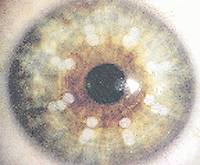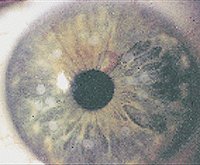Ho:YAG LTK may be an alternative to LASIK or PRK to treat hyperopia
This technique may offer safety without the disadvantages often encountered with other methods
At present, there are many methods available to correct hyperopia. Most of them are based on the ablation of tissue with an excimer laser in the periphery of the cornea (laser in situ keratomileusis or hyperopic photorefractive keratectomy). Refractive surgeons may obtain good results with these methods; however, they do have their disadvantages. They are performed close to the visual axis, and the functional optical zone in the cornea is too small (centration is critical, contrast sensitivity sometimes decreases and loss of best spectacle corrected visual acuity [BSCVA] may result).
Non-contact holmium YAG laser thermal keratoplasty (Ho:YAG LTK) is another option for correction of hyperopia, a safe technique based on the use of laser heat to alter the properties and structure of corneal stromal collagen in order to steepen the corneal curvature.
Study population
 ---Photograph shown immediately postoperatively of a three ring treatment for hyperopia. The white opacity produced by the thermal keratoplasty will disappear in the next 6 months.
---Photograph shown immediately postoperatively of a three ring treatment for hyperopia. The white opacity produced by the thermal keratoplasty will disappear in the next 6 months.
We treated 116 patients using this method. The mean age was 50 years and the mean uncorrected visual acuity (UCVA) was 20/80 (20/400 to 20/25). The BSCVA was 20/25 (20/50 to 20/20). Preoperative subjective manifest refraction was +2.5 (+0.75 to +4.75). All patients were 40 years of age or older. The preoperative corneal pachymetry was thinner than 550 µm and the keratometry was less than 45 D.
For the procedure, the patient was seated in front of the slit-lamp delivery system. Topical anesthesia was applied, and the patient fixated on a red diode light. After the cornea was dry enough, one to three rings of eight laser spots were applied to the cornea for only 2 seconds in a 5-mm to 7-mm optical zone. In all cases, the energy of treatment was 240 mJ. The eye was occluded for just 24 hours. The Corneal Shaping System (Sunrise Technologies Inc., Fremont, U.S.A.) was used in all surgeries.
UCVA improved
 --- Photograph of a patient’s eye after treatment with laser thermal keratoplasty for hyperopic astigmatism. Two rings of spots are placed on the flattened axis and one ring of eight spots is used for the correction of the spherical equivalent.
--- Photograph of a patient’s eye after treatment with laser thermal keratoplasty for hyperopic astigmatism. Two rings of spots are placed on the flattened axis and one ring of eight spots is used for the correction of the spherical equivalent.
Results obtained after 12-month follow-up were as follows: UCVA for distance changed from 20/80 preoperatively to 20/40 at the 6-month and 1-year follow-up. At this time, 40% of eyes had UCVA of 20/30 or better and BSCVA remained at 20/25 as in the preoperative examination.
Only 2% of eyes lost one Snellen line in BSCVA. The mean spherical equivalent of subjective manifest refraction improved from +2.5 preoperatively to +0.75 at the 1-month follow-up, and tended to stabilize from the 6-month (+1.5) to the 12-month (+1.25) follow-up. There were no severe complications. Only mild pain, tearing and foreign body sensation were reported during the first 48 hours.
Conclusion
We believe that LTK is a safe and effective procedure to treat low to moderate hyperopia (up to +2.5) in patients 40 years of age or older. It is a simple and quick procedure that is minimally invasive, well tolerated and offers quick rehabilitation. Safety was demonstrated by minimal loss in BSCVA, the visual axis was left untouched and there were no complications related to intraocular pressure.
Many patients achieved a considerable improvement in near subjective visual acuity and also in middle distance — an aspect highly appreciated by hyperopic patients due to the multifocal effect of this procedure.
Postoperative regression was the main limitation of the procedure, and we believe this may be avoided with better patient selection and future technical development.
For Your Information:
- Hugo Daniel Nano, MD, is president of the Argentine Society of Refractive Surgery and Córnea. He can be reached at Clinica de Ojos Dr. Nano, Blas Parera 4201, Olivos, 1636, Argentina; +(54) 1-717-4000; fax: +(54) 1-717-3556; e-mail: hnanojr@internet.siscotel.com. Dr. Nano has no direct financial interest in the products mentioned in this article, nor is he a paid consultant for any companies mentioned.
